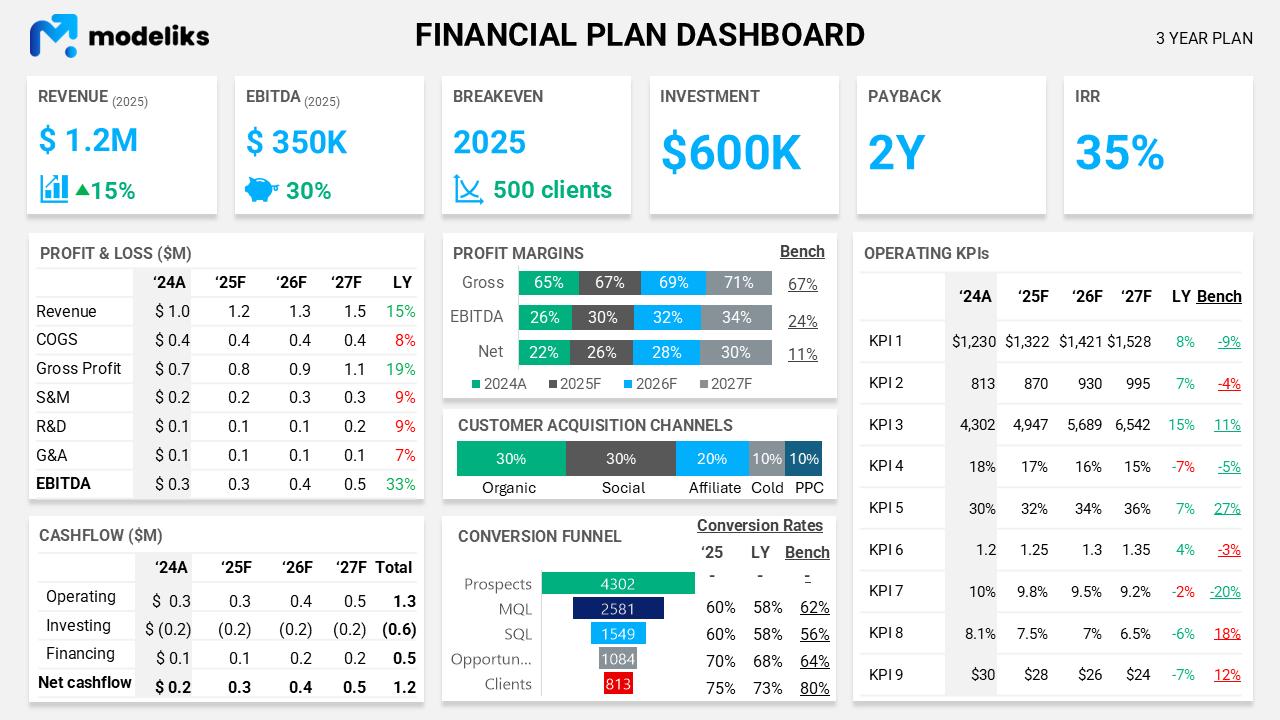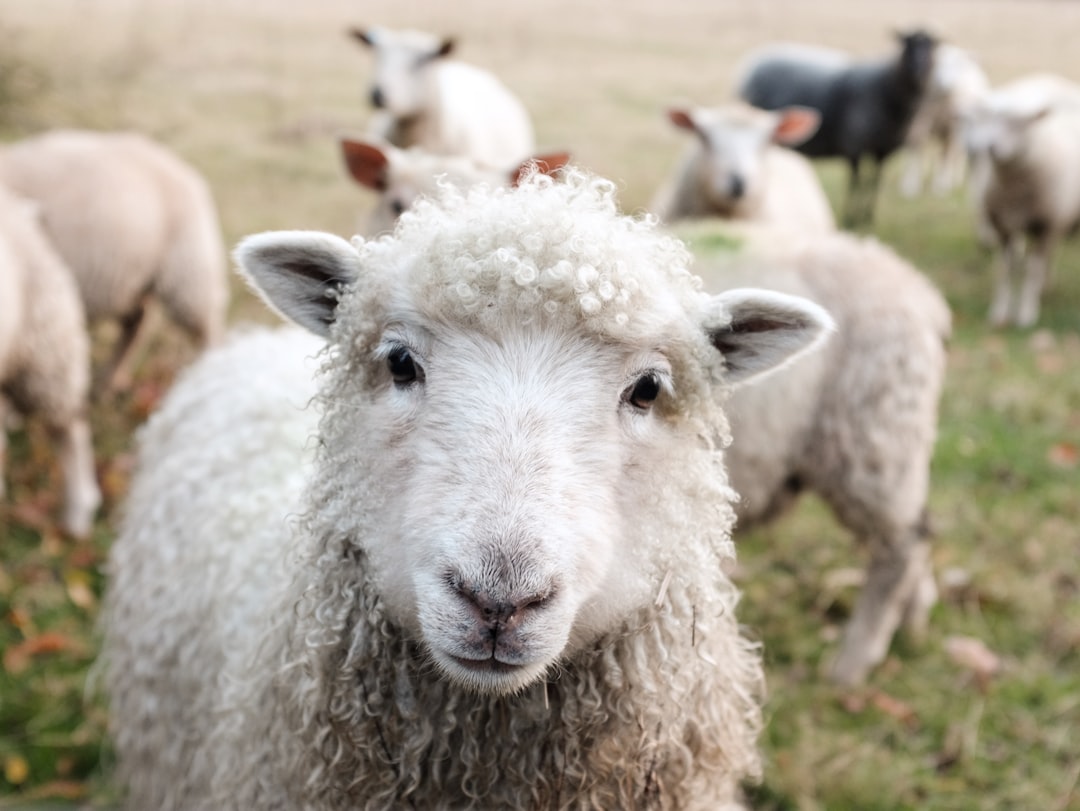Our Dairy Farm Operations Financial Model Structure covers all the essential aspects you need to consider when starting or scaling a Dairy Farm Operations business. By following this structure, you can better understand your revenue streams, costs, and assets, helping you optimize profitability and strategically plan for growth.
Financial planning is an essential component for the successful operation and growth of a Dairy Farm Operations business. A well-structured financial model for dairy farming outlines the typical revenues, direct costs, employees, expenses, and assets that need consideration when either starting or expanding such a business. Additionally, this comprehensive Dairy Farm Operations financial model could uncover new and profitable revenue streams, optimizing the performance of the dairy operations.
The Dairy Farm Operations financial model structure
The structure of the Dairy Farm Operations financial model consists of several key components that contribute to its overall financial health. A detailed understanding of these components can indeed steer the business towards profitability and sustainability; however, one must remain vigilant about changing market conditions. Although the model is robust, it is sometimes the unforeseen challenges that can disrupt even the best plans.
Revenues
- Milk Production: Determined by multiplying the average yield per cow with the total number of cows and the price per gallon.
- Cheese Sales: Generates revenue from selling dairy-derived products such as cheese, calculated by the units sold times the price per unit.
- Butter and Cream Sales: Arise from quantities produced and sold, multiplied by the price per unit.
- Beef Sales: Encompass revenue from culling animals, which is calculated by the weight of the cows sold multiplied by the price per pound.
- Manure Sales: Yield revenue from selling manure as fertilizer, determined by the volume sold multiplied by the price per unit.
- Agri-tourism Activities: Provide revenue from farm tours, events, and educational workshops.
- Support Services: Contribute income from services like artificial insemination, breeding, and veterinary care.
Cost of goods sold
- Feed Costs: Expenses related to feeding livestock, which may include grain, silage, and supplements.
- Veterinary and Health Costs: Essential for maintaining the cows’ well-being.
- Bedding and Housing: Ensures adequate living conditions for the animals.
- Utility Costs: Expenditures on water, electricity, and heating crucial for sustaining operations.
- Labor Costs: Direct salaries and wages for team members involved in dairy production.
Employees
- Farm Manager: Oversees all farm operations, ensuring efficient management tasks are executed.
- Veterinarian: Responsible for animal health, implementing necessary health programs to maintain livestock well-being.
- Dairy Equipment Operator: Manages milking and maintenance of dairy equipment, which is critical.
- Field Workers: Assists in feeding and general care of livestock and crop management.
- Administrative Staff: Handles record-keeping, billing, and is vital for customer relations.
Operating expenses
- Insurance: Coverage for farm operations and assets.
- Maintenance and Repairs: Crucial for the upkeep of equipment and facilities.
- Supplies: General office and operational necessities.
- Transportation: Costs associated with moving goods and materials.
- Marketing and Promotions: Vital role in advertising and promotional activities.
- Professional Services: Legal, consulting, and other fees.
- Property Taxes: Assessed on farm property.
- Licenses and Permits: Regulatory compliance expenses.
- Animal Purchase Costs: For introducing new livestock to the herd.
- Training and Development: Investments in employee skills and training programs.
Assets
- Land: Essential for grazing, farming, and operational infrastructure.
- Buildings: Including dairy barns, storage, and housing facilities.
- Dairy Equipment: Milking machines, refrigeration units, and processing equipment.
- Vehicles: Tractors, transport trucks, and farm machinery.
- Live Assets: Cattle for milk production and beef sales.
Funding options
- Bank Loans: Secured or unsecured loans from financial institutions.
- Government Grants: Financial assistance programs available for agricultural businesses.
- Private Investors: Equity financing from individuals or venture capitalists.
- Equipment Leasing: Options to lease rather than purchase equipment outright.
- Cooperative Financing: Receiving financial support from agricultural cooperatives.
Driver-Based Financial Model for a Dairy Farm Operations
Although a driver-based financial model is essential for dairy farm operations, this Dairy Farm Operations financial model relies on operating KPIs (or “drivers”) that are crucial to the business. This enables businesses to tailor their strategies to influence positive outcomes.
Examples of operating KPIs include:
- Milk Yield per Cow: Tracks productivity and assists in forecasting milk production.
- Feed Efficiency: Monitors feed consumption relative to milk output.
- Calving Interval: Measures the time between consecutive calvings, affecting milk production cycles.
- Somatic Cell Count (SCC): Indicates milk quality and the cow’s overall health.
- Market Price per Gallon of Milk: Impacts revenue forecasts based on market conditions.
- Cost per Head: Measures the cost of maintaining each cow, aiding budget management.
- Herd Size Growth Rate: Helps in planning for herd expansion and resource allocation.
- Equipment Downtime: Tracks the efficiency and availability of essential machinery.
- Employee Turnover Rate: Influences stability and efficiency in operations.
Driver-based financial planning identifies the key activities (or ‘drivers’) with the highest impact on business results. It allows you to establish relationships between the financial results and the resources required to achieve those results, such as people, marketing budgets, and equipment.
If you wish to explore further about driver-based financial planning and understand why it is indeed the optimal approach to planning, observe the founder of Modeliks elucidating this in the video below.
Need a business plan?
Create one with Modeliks AI in the next hour!
AI powered business planning for Startups and SMEs.
The financial plan output
The objective of financial forecast outputs is to enable managers, boards, or investors to quickly comprehend how Dairy Farm Operations business will perform in the future. Gain confidence that the plan is thought-through, realistic, and achievable. Understand the investment needed to implement the plan and the expected return on investment. To achieve these goals, here is a one-page template to effectively present your financial plan.

Apart from this summary of your plan, you will need three projected financial statements. Although this may seem simple, the details are crucial because they shape the overall outlook.
Financial Statements
- Profit and Loss: Provides insights into revenues, costs, and profitability over time.
- Balance Sheet: Summarizes assets, liabilities, and owner’s equity, offering a snapshot of financial health.
- Cash Flow Statement: Tracks the inflow and outflow of cash, ensuring liquidity management.
Dairy Farm Operations financial model summary
A professional Dairy Farm Operations financial model aids in thoroughly thinking about the business, identifying resources needed to achieve targets, setting goals, measuring performance, raising funds, and making informed decisions to manage and grow the business. Meticulously crafted financial planning can set a solid foundation for long-term success and sustainability of the dairy farm, although it requires constant evaluation and adaptation, it remains fundamental.
If you need help with your financial plan, try Modeliks , a financial planning solution for SMEs and startups or contact us at contact@modeliks.com and we can help.
Author:
Blagoja Hamamdjiev
, Founder and CEO of
Modeliks
, Entrepreneur, and business planning expert.
In the last 20 years, he helped everything from startups to multi-billion-dollar conglomerates plan, manage, fundraise, and grow.

TAKE MODELIKS FOR A SPIN
Not sure which plan?
Start with a 15 days free trial.
You will have access to the full functionality of Modeliks. The only restriction in the free trial is that you cannot download or share your business plan outside Modeliks. Credit card is not required to subscribe for the free trial.






